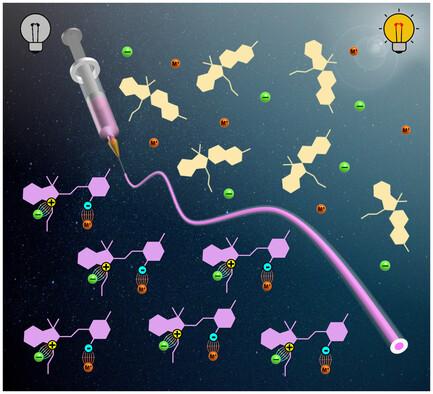基于可穿戴设备、电子皮肤和热管理织物的柔性纤维可见光传感器
IF 11.1
Q1 MATERIALS SCIENCE, MULTIDISCIPLINARY
引用次数: 0
摘要
可见光是地球上所有生物的重要能源。鉴于可见光的重要性,可见光传感器引起了科学家们的广泛兴趣。随着可穿戴设备的快速发展,其中使用的传感器需要具有柔性、可伸缩性和轻质等特点。本文开发了一种基于螺吡喃(SP)的智能电解质,它能对可见光做出反应。在可见光照射下,SP/FeCl3-6H2O 甲基氰化物(MeCN)水溶液电阻的可逆变化率高达 19.26%。此外,以 SP/FeCl3-6H2O MeCN 水溶液和硅橡胶中空纤维分别作为核心层和外层,制备了具有核心-鞘结构的柔性导电纤维可见光传感器。然后将这些纤维状可见光传感器编织成具有多种功能的织物,如感应和定位可见光、可逆光致变色和热管理。本研究制备的纤维可见光传感器和织物在时装、智能纺织品、柔性导电纤维、柔性纤维传感器、电子皮肤和可穿戴设备等领域具有广阔的发展前景和应用潜力。本文章由计算机程序翻译,如有差异,请以英文原文为准。

Flexible Fibrous Visible Light Sensors Based on Spiropyran for Wearable Devices, Electronic Skins, and Thermal Management Fabrics
Visible light is an important energy source for all living organisms on Earth. Given the importance of visible light, visible light sensors have attracted widespread interest from scientists. With the rapid development of wearable devices, the sensors used in them need to be flexible, stretchable, and lightweight. Herein, an intelligent electrolyte based on spiropyran (SP) that responds to visible light is developed. The reversible change rate in the electrical resistance of an SP/FeCl3·6H2O methyl cyanide (MeCN) aqueous solution under visible light irradiation is as high as 19.26%. Additionally, flexible and conductive fibrous visible light sensors with a core-sheath structure are prepared using an SP/FeCl3·6H2O MeCN aqueous solution and silicon rubber hollow fibers as the core and outer layers, respectively. These fibrous visible light sensors are then woven into fabrics with multiple functions, such as sensing and locating visible light, reversible photochromism, and thermal management. The fibrous visible light sensors and fabrics prepared in this study have broad development prospects and application potential in the fields of fashion, smart textiles, flexible conductive fibers, flexible fibrous sensors, electronic skins, and wearable devices.
求助全文
通过发布文献求助,成功后即可免费获取论文全文。
去求助
来源期刊
CiteScore
14.00
自引率
2.40%
发文量
0
期刊介绍:
Small Science is a premium multidisciplinary open access journal dedicated to publishing impactful research from all areas of nanoscience and nanotechnology. It features interdisciplinary original research and focused review articles on relevant topics. The journal covers design, characterization, mechanism, technology, and application of micro-/nanoscale structures and systems in various fields including physics, chemistry, materials science, engineering, environmental science, life science, biology, and medicine. It welcomes innovative interdisciplinary research and its readership includes professionals from academia and industry in fields such as chemistry, physics, materials science, biology, engineering, and environmental and analytical science. Small Science is indexed and abstracted in CAS, DOAJ, Clarivate Analytics, ProQuest Central, Publicly Available Content Database, Science Database, SCOPUS, and Web of Science.

 求助内容:
求助内容: 应助结果提醒方式:
应助结果提醒方式:


